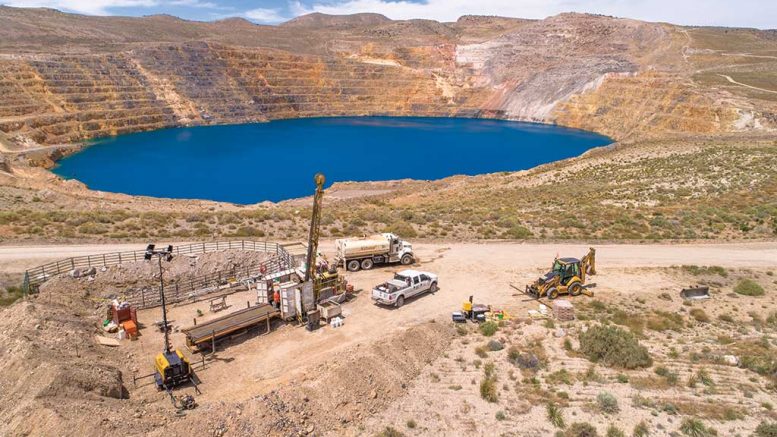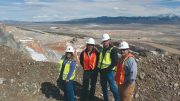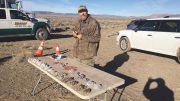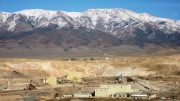Premier Gold Mines (TSX: PG; US-OTC: PIRGF) expects two new mines will come online over the next 12 to 18 months in Nevada at its South Arturo project, a 40%-owned joint venture with Barrick Gold (TSX: ABX; NYSE: GOLD).
Production from South Arturo’s phase-one open pit is expected to start sometime in early or mid-2020, while the El Nino underground mine — a down-plunge extension of the joint-venture’s phase-two open pit that was mined from 2016–2017 — will ramp up late in the second half of 2019.
“We should see a continuous expansion of Premier’s production profile,” Ewan Downie, the company’s president and CEO, tells The Northern Miner. “We’re quite excited about the company we’re building … hopefully, in the not-too-distant future, we’ll be generating sufficient cash flow to start giving it back to our shareholders.”
South Arturo is 5 km from Barrick’s Goldstrike operation and 40 km northwest of the town of Carlin in Elko County. Mineralized material from South Arturo is processed at Goldstrike.
The two open-pit mines and underground El Nino project are on the site of the reclaimed Dee open-pit mine, where mining last took place in the late 1990s. Between 1984 and 1999, the Dee mine produced 605,000 oz. gold from oxide ore. (The joint venture’s phase-one, open-pit mine that is being built is the extension of the past-producing Dee pit.)

Premier Gold Mines president and CEO Ewan Downie in front of a portal at its 40%-owned South Arturo gold project in Elko County, Nevada. Credit: Premier Gold Mines.
Underground production started in 1999 and continued until December 2000, when both the open-pit and underground operations were shut down, and surface facilities were reclaimed. Barrick found the South Arturo deposit in July 2005 after drilling beneath the Dee open-pit mine’s waste disposal facilities.
Premier acquired its 40% stake in South Arturo in June 2015 from Goldcorp (TSX: G; NYSE: GG).
Along with building the open pit, heap-leach material is being stockpiled for potential future processing. Premier plans to review engineering designs for the heap-leach option this year, and if approved, construction of the facility could begin in 2020.
The company has also drilled several holes east of the phase-one pit that it is calling the East Dee target, which it says could become a mining centre on the property. Drilling last year at East Dee returned notable intersections, such as 12.78 grams gold per tonne over 5 metres within a broader intercept of 21 metres grading 6.52 grams gold, starting from 279 metres downhole; and 4.50 grams gold over 21 metres, starting from 243 metres downhole.
The junior is confident that exploration success at South Arturo could support at least one other open-pit mine, which it is calling “phase three,” next to the two other open pits on the property.
Highlights from 2018 drilling at the phase-three target include 1.36 grams gold across 154 metres from 239 metres downhole; 1.34 grams gold over 24 metres from 237 metres; 1.32 grams gold over 21 metres at 338 metres’ depth; and 0.95 gram gold over 18 metres from 250 metres downhole.
Exploration drilling this year will focus on East Dee, El Nino and high-priority targets near the centre of the pits. Definition drilling at the East Dee target will lay the basis for a new resource estimate, while drilling at El Nino focuses on reserve definition and expansion.
Premier increased its exposure to Nevada in November 2018 through an option agreement with Ely Gold to acquire a 100% stake in the Rodeo Creek property, adjoining South Arturo, 10 km northwest of Goldstrike. The 510 km land package abuts Halliburton’s Rossi Barite mine at its north boundary. Under the option deal, Premier must pay Ely Gold US$500,000 over five years, and Ely Gold will retain a 2% net smelter return royalty.
Premier notes that a historic geochemical survey of the Rodeo Creek property confirmed that several of the property’s fault structures coincide with arsenic-antimony geochemical signatures. This year Premier is planning a soil sampling and geological mapping program, along with compilation of historic data. Drilling is planned for priority targets.
Elsewhere in Nevada, Premier is working on mine development opportunities at its Cove, McCoy-Cove and Rye projects.
Premier’s wholly owned Cove property is in northern Nevada’s Battle Mountain trend, 20 km south of Newmont Mining’s (NYSE: NEM) Phoenix mine and 50 km southwest of Battle Mountain. The Cove deposits consist of the Helen, Gap, Cove South Deep (CSD) and 2201 zones, which are located beneath the historically mined Cove open pit, and extend 600 metres northwest from the pit.

Premier Gold Mines and Barrick Gold’s South Arturo gold project in Nevada. Credit: Premier Gold Mines.
Echo Bay Mines mined Cove between 1987 and 2001, and produced 2.6 million oz. gold and 100 million oz. silver. Production from heap-leach pads continued until 2006.
The Helen and Gap zones are Carlin-style, disseminated refractory gold deposits. Mineralization in the CSD is associated with disseminated sulphides, with silver to gold ratios of 50:1 to more than 100:1. The 2201 zone is made up of disseminated sulphides within sheeted stockwork veins, with lead and zinc concentrations.
Cove has an indicated resource of 1.05 million tons grading 0.327 oz. gold per ton and 0.861 oz. silver per ton, for 342,000 contained oz. gold and 900,000 oz. silver. Inferred resources add 4.03 million tons at 0.328 oz. gold per ton and 0.609 oz. silver per ton for 1.32 million contained oz. gold and 2.46 million contained oz. silver.
Results from a preliminary economic assessment released in May 2018 support Premier’s plan to build an exploration ramp to define and expand the deposits in advance of a feasibility study. The PEA estimated average gold production of 92,400 oz. a year over an eight-year mine life, for total life-of-mine production of 740,000 oz. gold. Cash costs were an estimated US$788 per oz. and all-in sustaining costs of US$897 per oz. gold. Mine construction would cost an estimated US$46.6 million, with sustaining capital of US$67.7 million.
The study is based on resources in the Helen and Gap deposits only. Premier says there is potential to boost resources at Helen and Gap because they remain open for expansion. The company also says there is potential to add resources from the CSD and 2201 zones with underground exploration and delineation drilling. Premier is working on a hydrological flow study and more permitting, with the view that the Cove deposit could become Premier’s next wholly owned mine development.
“It’s likely one of the highest-grade, undeveloped plus 1 million oz. deposits in North America,” Downie says of Cove. “If it weren’t refractory it would be my favourite project for sure. We have to work with Barrick or Newmont to process that ore, and those will be some of the dealings we’ll do this year to hopefully get the project ready for full-scale production.”

Premier Gold Mines’ wholly owned Mercedes gold-silver mine in northern Mexico’s Sonora state. Premier bought the mine from Yamana gold in July. Credit: Premier Gold Mines.
A year ago, Premier and Barrick signed a comprehensive agreement giving the gold major the right to earn a 60% interest in the McCoy-Cove property, which surrounds but excludes Premier’s Cove deposit, referred to as “the Cove carve-out.”
Under the agreement, Barrick must spend US$22.5 million on exploration before July 2022. The 2018 exploration program found potential for two trends parallel to the Helen-Gap-CSD trend — the Piezo trend and the Alpha trend. Exploration included geochemical and rock-chip sampling to upgrade historic information. Rock chips returned high-grade gold values of up to 105 grams gold and 40.3 grams gold. Some samples also returned lead and zinc mineralization.
“Given Cove is a refractory deposit, we would need a roaster or autoclave in order to pull the gold out of the deposit, and we don’t want to permit and build a roaster in Nevada, so the question became: do we bring in a partner for the whole project, or part of it,” Downie says. “Barrick was quite interested in working with us on the overall project, but we weren’t able to agree to terms for them to earn-in into everything, but we did work out terms where they’re helping us to explore surrounding ground. They also gave us a guaranteed processing agreement, at least for a bulk sample from the project, and we’re hoping the relationship we build both through this and South Arturo will lead hopefully to a longer-term processing option for that project.”
As part of the deal, Barrick is allowing Premier to earn 100% of the Rye property — a high-grade prospect found in the 1980s that has been idle for a decade. “We identified it as being one of the high-quality opportunities in Nevada that was sitting in a major, and not being worked,” Downie says. “So while we gave up a project we got a project, and our expectation is that if it works out, it would be non-refractory, and we could produce without using a third-party roaster or autoclave.”
Barrick has a back-in right on Rye by spending US$3 million on exploration before the end of 2019.
The Rye property has a gold-bearing, low-sulphidation epithermal vein system. The Rye vein has been traced on surface over a strike length of more than 2.5 km, with mapped widths of up to 30 metres. Previous shallow drilling at Rye has returned intercepts with gold grades of up to 139.2 grams gold.
Rye is next to the Goldbanks property, where Premier has a joint-venture earn-in agreement with Kinross Gold (TSX: K) to acquire a 50% stake in the project.
With two new mining operations under construction at South Arturo, and an underground program planned for Cove during the second half of 2019, Premier decided to raise money. In January it signed a definitive credit agreement with Investec Bank PLC for a US$50-million, secured revolving-term credit facility — the first revolver the company has ever signed.
“We were one of the few producers out there without a revolver facility,” Downie says. “We don’t intend to draw from that in 2019, but it does give us access to capital if things change, without being in panic mode.”
In addition, Premier has signed a deal with Orion Mine Finance for total proceeds of US$18.2 million — giving the mine financier 12.4% of Premier’s total issued and outstanding shares.
“Now our treasury is very strong, with $110 million to $120 million, and our market cap is $355 million,” he says. “For a Canadian company that is unheard of, and currently we have no debt, so we are in a good position to look at whatever opportunities may come up.”
“I’d like to think with our growth profile this year and new mines coming online, that we should perform better and better as the year goes on,” Downie says. “Premier has one of the best growth profiles of any company period, be it big or small, and we’ve built a very solid team to manage these projects.”
Outside the U.S., Premier owns Mercedes, an underground gold and silver mine in the state of Sonora in northern Mexico, and a 50% stake in the Greenstone gold project (also known as Hard Rock), 275 km northeast of Thunder Bay in northern Ontario’s Beardmore-Geraldton greenstone belt. In December, the federal government approved the environmental assessment for the project.
The federal permit “is a major milestone” in the permitting process, Downie says.
“We expect in the first half of this year that the provincial government will approve the EA,” he says, “which could make Hard Rock one of Canada’s next major gold mines.”
At press time, Premier was trading at $1.75 per share in a 52-week trading range of $1.39 to $3.64 per share.
CIBC has a 12- to 18-month price target on the company of $3 per share, and an “outperform” rating.






Be the first to comment on "Premier Gold to launch two mines in next 18 months"